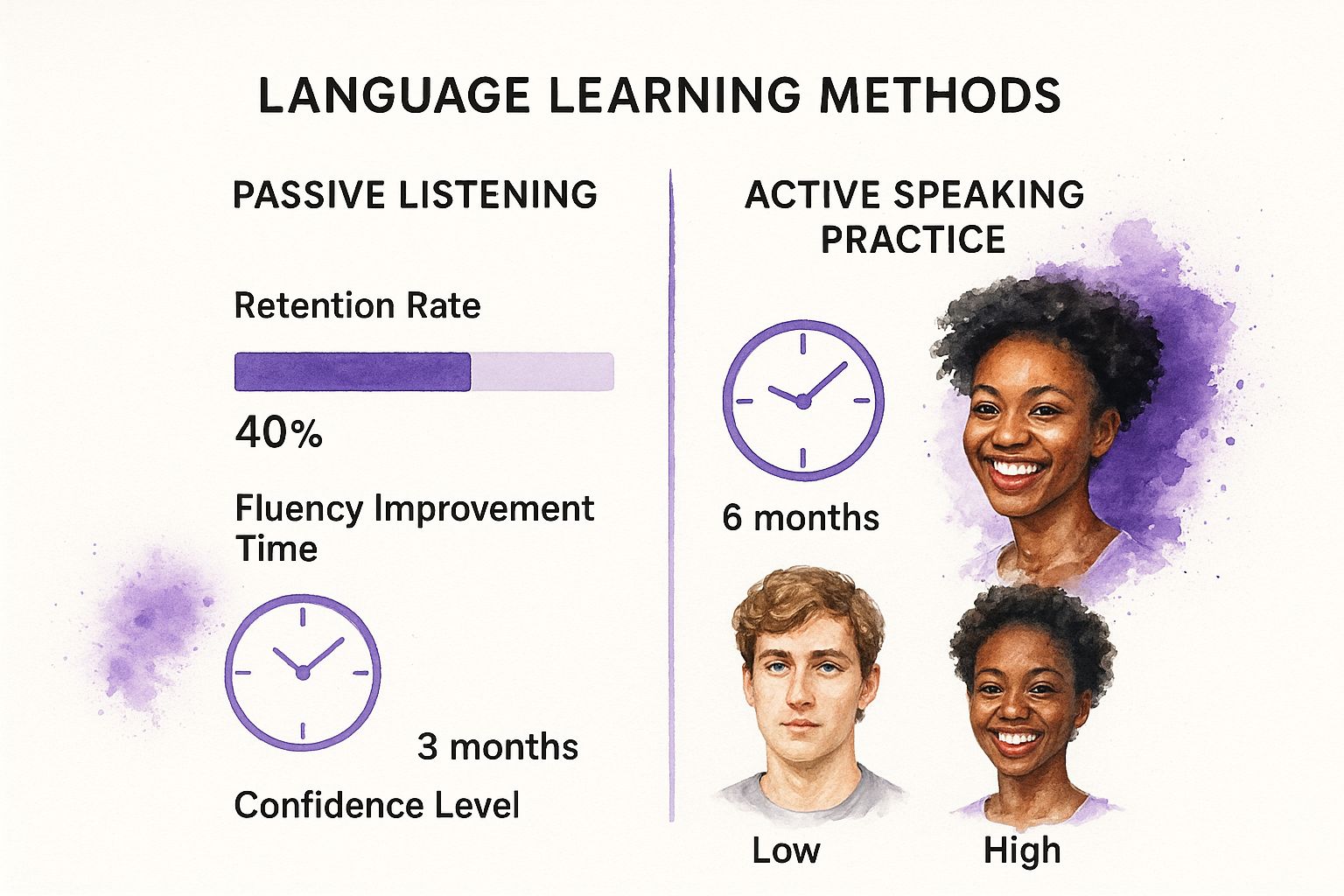Speak English With Fluency A Practical Guide
Ready to speak English with fluency? Our guide offers practical tips and real-world routines to boost your confidence and master natural communication.


To truly become fluent in English, you have to move beyond just knowing the language and start using it. The real secret isn't cramming more grammar rules; it's about weaving small, consistent speaking habits into your daily life. It’s all about progress, not perfection. Every little moment can be a chance to practice.
Your Path to Fluent English Begins Here
Do you ever feel stuck? You might know hundreds of grammar rules and have a massive vocabulary list, but when you open your mouth to speak, the words just don't come out right. This is an incredibly common roadblock, and trust me, the answer isn't more flashcards. It's time to shift your entire mindset from studying English to actually living it.
The objective is to make speaking feel as natural as breathing. Think about your native language—you don't actively translate thoughts or stress over sentence structure, you just... talk. Getting to that point in English is completely achievable. It just takes building new mental pathways through daily, active use.
The Mindset of a Fluent Speaker
Before we get into the practical stuff, we have to talk about mindset. This is where most people get tripped up. The fear of making a mistake can be paralyzing, leading to hesitation and, worse, silence. But here's what fluent speakers understand: mistakes aren't failures. They're just data points that show you where to improve.
True fluency isn't about speaking perfect, textbook English. It's about getting your ideas across confidently and effectively, even if you make a few mistakes along the way. The goal is connection, not flawless grammar.
You have to embrace this idea from the get-go. Give yourself permission to be a little messy. Every conversation, even a clumsy one, is like a rep at the gym for your speaking muscles. Moving your focus from perfection to connection is the first real step toward unlocking your speaking ability.
The Power of Global Connection
Don't forget why you're doing this. English is the world's language of connection. By 2025, it's projected to be spoken by over 1.5 billion people—that’s roughly 20% of the global population! This isn't just a subject you're learning; it's an invitation to join a massive, global conversation that opens doors to new friendships, career opportunities, and incredible cultural experiences.
Taking Your First Steps
Momentum is everything. You don't need to carve out huge chunks of your day for studying. Instead, sprinkle tiny, manageable speaking habits into the routine you already have. This makes learning feel less like a chore and much more sustainable.
To get the ball rolling, I've put together a quick table of foundational habits you can start today.
| Immediate Actions for English Fluency |
| :--- | :--- | :--- |
| Action | Why It Works | Time Commitment |
| Narrate Your Day | Turns mundane activities into active practice. "I'm making coffee." "I'm looking for my keys." | 1-2 minutes, several times a day |
| Think in English | Builds the habit of forming thoughts directly in English, bypassing translation. | 5 minutes, 2-3 times a day |
| Switch Your Media | Creates a passive immersive environment by changing your phone or music to English. | Instant (one-time setup) |
These small shifts start creating an English-centric environment around you, keeping your brain tuned into the language all day long. And when you're ready for more structured, interactive practice, a tool like the TalkEasy AI conversation platform gives you a safe, judgment-free space to build confidence on your own terms.
Building Your Daily Fluency Routine

To really speak English fluently, you need more than a weekly lesson. You need a daily rhythm. It's this consistency that transforms scattered efforts into powerful, automatic habits. The secret is to weave English into your life so seamlessly that it stops feeling like "studying" and just becomes part of your day.
This isn't about finding an extra hour you don't have. It's about capturing those small, unused pockets of time and putting them to work. Think of it like building a muscle—short, regular workouts are always more effective than one grueling marathon session a month.
Weave English into Your Morning
The way you start your morning can set the tone for your entire day. Instead of mindlessly scrolling through social media while your coffee brews, use those five minutes for a quick English warm-up. This simple swap wakes up the English-speaking part of your brain.
One of the most powerful techniques I've seen is shadowing. Just find a one-minute audio clip from a native speaker—it could be from a podcast, a news report, or even a movie scene. Play it and repeat what they say right after them, trying to match their rhythm, tone, and intonation. You're not just practicing words; you're practicing the music of the language.
Another fantastic morning habit is to narrate your own actions. As you get ready, just say what you're doing out loud: "Okay, I'm brushing my teeth." "Where did I put my keys?" It sounds almost silly, but it builds the crucial habit of forming English sentences on the fly.
Turn Downtime into Uptime
Every single day is filled with little moments of transition: your commute, waiting in line for lunch, a short break between tasks. These are golden opportunities. Instead of letting this time evaporate, you can use it to surround yourself with English.
Here’s how you can reclaim that "dead time":
- Your Commute Companion: Swap your usual playlist for an English podcast on a topic you actually find interesting. Whether it's true crime, tech reviews, or comedy, your passion makes the learning feel effortless. You'll absorb natural vocabulary and sentence structures without even realizing it.
- Quick Vocabulary Wins: Use a flashcard app like Anki for just five minutes while waiting for the elevator. My advice? Focus on whole phrases, not just single words. This helps you learn vocabulary in its natural context.
- The Journaling Habit: Before you go to sleep, write just one or two sentences in English about your day. It can be as simple as, "Today's meeting was long, but I learned something new." This little ritual helps you process your thoughts in English.
Your environment is your greatest teacher. The more you fill it with English sounds, sights, and thoughts, the faster your brain will adapt and begin to operate in the language naturally.
This kind of immersion doesn't require a plane ticket. It just requires a conscious decision to change what you see and hear every day.
Design a Routine That Actually Sticks
Let's be honest: the best routine is the one you can actually follow. A plan that looks perfect on paper but doesn't fit your real life will be abandoned within a week. The goal here is to build a flexible framework, not a rigid, unforgiving schedule.
Here are a couple of sample routines to give you some ideas:
For the Busy Professional
- Morning (10 mins): Listen to a business news podcast in English during your commute.
- Lunch Break (15 mins): Use an AI conversation partner to practice a common work scenario, like giving a project update.
- Evening (5 mins): Before logging off, write a quick email draft in English to practice professional communication.
For the University Student
- Morning (5 mins): Watch a short educational YouTube video in English on a subject you're studying.
- Between Classes (10 mins): As you review your lecture notes, try to summarize the key points out loud in English.
- Evening (20 mins): Hop on an online language exchange to chat with a native speaker about your hobbies.
Your routine is going to evolve, and that’s perfectly fine. The most important thing is to do something every single day.
For those looking to bake structured conversation practice right into their schedule, platforms like TalkEasy can provide instant, AI-guided dialogues that fit into even the busiest of days. You can see how it works by creating a personalized learning plan on TalkEasy.
By combining these small, daily habits, you create a powerful, cumulative effect. Before you know it, you won’t just be "practicing" English—you'll be living it.
Mastering Real-World English Conversations

Alright, it's time to take your English out of the classroom and into the wild. All the grammar rules and vocabulary lists in the world are just a starting point. Real, lasting fluency is forged in the fire of live conversation. This is where you learn to think on your feet and turn that passive knowledge into active, confident speech.
So many learners fall into the "I'll speak when I'm ready" trap. Here's a little secret from my own experience: that day never arrives on its own. You build confidence by doing, not by waiting. Every chat, from a quick "how are you?" to a deep discussion, is a rep that strengthens your speaking muscles.
Finding Your Conversation Partners
First things first, you need people to talk to. The great news is that in our hyper-connected world, you have more options than ever before. You absolutely do not need to live in an English-speaking country to get daily practice. The trick is to find situations where you feel comfortable enough to stumble a bit.
Here are a few solid ways to find your tribe:
- Language Exchange Apps: Tools like Tandem or HelloTalk are brilliant. They connect you with native English speakers who are just as eager to learn your language. It’s a perfect setup—everyone is patient, and you're both a teacher and a student.
- Local Meetup Groups: A quick search on sites like Meetup.com can reveal English conversation groups or international clubs right in your city. These are fantastic for relaxed, real-world practice with all sorts of interesting people.
- Online Communities: Dive into forums or social media groups built around your passions. Are you into gaming, photography, or classic films? Joining discussions there is a completely natural way to use English.
My best advice? Don’t just look for a "tutor." Look for a friend. When you genuinely connect with someone over a shared interest, you forget you're "practicing." The conversation just flows.
Aim to schedule at least one or two real conversations into your week. You’ll be amazed at the difference it makes.
Turning Everyday Moments into Practice
You don't always need to block off an hour for a formal chat. Your daily routine is peppered with golden opportunities for quick, low-stakes practice. These little "micro-conversations" are incredible confidence builders.
Think about your day. That trip to the coffee shop? That’s a practice session. Instead of just pointing, use a full sentence: "Hi, could I please get a large latte with oat milk?" Making small talk with a cashier or asking a stranger for directions are perfect chances to flex your English.
These tiny interactions accomplish two crucial things:
- They make speaking English feel normal. It stops being a big, scary event and becomes just another part of your day.
- They give you instant feedback. You know immediately if you were understood, which is a huge psychological win.
The key is to reframe your mindset. Stop seeing these moments as chances to make a mistake. Start seeing them as free, easy opportunities to get better.
Keeping the Conversation Flowing
So, you've started a conversation. How do you stop it from fizzling out after 30 seconds? The secret isn't just about what you say—it's about how you listen. Active listening is a language learner's superpower because it takes the pressure off you to constantly come up with the next thing to say.
Pay close attention when your partner speaks. Listen for keywords, emotions, and topics you can ask a follow-up question about. It shows you're engaged and turns a monologue into a genuine dialogue.
Simple Ways to Start and Extend a Chat
| Situation | What to Say | Why It's a Game-Changer |
|---|---|---|
| Beginning a Chat | "What have you been up to lately?" | It’s open-ended and invites a real story, not just a "yes" or "no." |
| When You Don't Understand | "Could you say that another way?" | Far more natural than "What?" and gives them a chance to rephrase. |
| Keeping It Going | "That's interesting. Tell me more about..." | This shows you're actually listening and guides the chat to deeper topics. |
| Sharing Your Experience | "That reminds me of a time when..." | It's the best way to build rapport by connecting their story to yours. |
Look, you're going to make mistakes. It's an unavoidable—and essential—part of learning. Even native speakers mess up their words! The real goal is to get your point across. If you can't find the perfect word, describe it. If your grammar isn't perfect, don't sweat it. Clarity and connection will always be more important than perfection. Every single conversation you have is a victory.
How to Think Directly in English

If there's one habit holding you back, it's the constant mental translation. Hearing English, translating it to your native language, thinking of a reply, then translating that back into English... it’s exhausting. And it makes your conversations feel slow and awkward.
To truly speak English with fluency, you have to cut out the middleman. You need to learn how to think directly in English.
This is the big secret. It’s a cognitive leap that closes the gap between your thoughts and your speech, letting conversation flow naturally. The great news? It's a skill you can build with some smart, targeted practice.
Start Simple: Just Name Things
Let's begin by rewiring your brain to see the world through an English lens. You can do this right now, from wherever you are. Look around you and start mentally labeling objects, but only in English.
Don't think "escritorio" and then "desk." Just look at the object and let the word desk be the first thing that pops into your head. Do it with everything: window, laptop, chair, lamp, book. This simple exercise forces a direct connection between an object and its English name, completely bypassing the translation step.
Turn this into a constant, quiet habit. Do it while walking down the street (tree, car, building) or making breakfast (cup, toast, milk). It’s a low-pressure way to start populating your mind with English.
The goal is to stop seeing the world through the filter of your native language. When you look at a pen, the first word that comes to mind should be ‘pen,’ not its translated equivalent. This is the foundation of thinking in English.
Become the Narrator of Your Own Life
Once you're comfortable labeling single objects, it's time to move on to full sentences. The idea here is to become the running commentator of your own life, describing your actions to yourself in simple English.
Think of this as your private practice arena. No one is listening, so there’s zero pressure.
- Getting ready in the morning? "I'm brushing my teeth." "I need to find my keys."
- Working at your desk? "I am writing an email." "This meeting is running long."
- Cooking dinner? "I am chopping the onions." "I should add more salt."
This constant narration forces you to build complete thoughts and sentences in real-time. It’s an incredibly powerful way to strengthen the mental muscles you need for spontaneous conversation. You’re not just naming things anymore; you’re describing actions and situations—the very essence of speaking.
Plan, Ponder, and Opine in English
Ready to take it to the next level? Start moving your more complex thinking—like making plans or forming opinions—entirely into English. This is where you really cement the habit and make English your default for more abstract thoughts.
Instead of writing your to-do list in your native language, write it in English. Think through your schedule: “First, I have to finish this report. Then, I’ll go to the gym after work.” When you're trying to decide what to have for lunch, have that internal debate in English.
This is also the perfect way to practice expressing your views. After reading a news article or watching a movie, take a second to ask yourself, "What did I think of that?" Then answer internally: "I think the main character was very brave," or "That plot twist was completely unexpected." This internal rehearsal is what ultimately gets rid of hesitation and gives you that authentic confidence when you speak.
Using Technology to Accelerate Fluency
Not too long ago, becoming fluent often meant enrolling in expensive classes or even moving to another country. Today, you have a powerful language-learning toolkit sitting right in your pocket. The trick is to use it for active practice, not just passive listening.
Watching movies is great, but it's not the same as actually speaking. When you intentionally build your own "tech stack," you can pinpoint your specific weaknesses and see your progress take off.
Choosing Tools for Specific Skills
Let's be honest, not all apps are created equal. A truly effective strategy involves mixing and matching different tools, each designed to sharpen a specific part of your speaking ability. This creates a well-rounded practice that covers all the bases.
Think of it like setting up a personal gym. You wouldn't just buy a treadmill and call it a day, right? You’d want equipment for strength, flexibility, and cardio. Your English tech stack should work the same way.
Here are a few ways to get started:
- For nailing your pronunciation: Apps like Elsie use voice recognition to analyze your speech, giving you instant feedback on tricky sounds and intonation. It's like having a pronunciation coach on call 24/7.
- For making vocabulary stick: Spaced repetition systems like Anki are fantastic for memorization. The pro move? Create flashcards with full sentences, not just single words. This teaches you how the vocabulary actually works in a real conversation.
- For real-world listening: Ditch the slow, boring "learner" podcasts. Instead, tune into content made for native speakers on topics you genuinely love—whether that’s tech, history, or true crime. This trains your ear to pick up on natural speed, rhythm, and slang.
The Power of AI Conversation Partners
One of the biggest hurdles for any English learner is finding consistent, judgment-free speaking practice. This is where AI tutors have completely changed the game for anyone wanting to speak English with fluency. They offer a safe space to talk, make mistakes, and build confidence without ever feeling embarrassed.
An AI conversation partner gives you unlimited chances to practice real-world scenarios. You can rehearse for a job interview, practice ordering coffee, or just chat about your hobbies—all on your own time. This kind of repetition in a low-pressure environment is what builds true speaking automaticity.
These tools are built to simulate real conversations, pushing you to respond on the spot. They’ll ask you follow-up questions, introduce new words, and even give you gentle corrections. It’s exactly the kind of consistent interaction you need to get the English out of your head and into your mouth. When you're ready to see this in action, you can get started with an AI tutor on TalkEasy and feel the difference.
This infographic really drives home the difference between just listening versus actively speaking. The results aren't even close.

As you can see, active speaking doesn't just feel more effective—the data shows it leads to much higher retention, faster improvement, and a serious boost in confidence.
Creating Your Personal Tech Stack
Your perfect set of tools will depend on your personal goals and where you need the most work. The key is to be strategic. Don't just download dozens of apps you'll never use. Pick a few that serve a clear purpose and make them part of your daily routine.
To help you choose the right tools for your specific fluency goals, here’s a quick breakdown of the different technology types available.
Comparison of English Learning Tools
| Tool Type | Best For | Example | Key Benefit |
|---|---|---|---|
| AI Conversation Tutor | Daily speaking practice | TalkEasy | Builds conversational confidence in a safe environment. |
| Pronunciation Coach | Refining your accent | Elsie | Provides instant, specific feedback on individual sounds. |
| Spaced Repetition App | Vocabulary retention | Anki | Uses cognitive science to help you remember words long-term. |
| Media Streaming | Listening immersion | YouTube / Podcasts | Exposes you to natural language on topics you find interesting. |
By combining these different technologies, you create a powerful, personalized system for learning. You might use your AI tutor for daily conversation, a pronunciation app to fix a specific sound that’s giving you trouble, and a podcast to sharpen your listening skills on your commute. This targeted approach ensures that every minute you spend learning is a minute spent making real, measurable progress.
Your Common Fluency Questions Answered
Embarking on the journey to speak English with fluency naturally brings up a lot of questions. As you start practicing and see yourself improving, it's normal to hit roadblocks and wonder if what you're doing is actually working. This section is here to tackle those common concerns with direct, practical advice.
Think of these questions not as problems, but as signposts on your path. Honestly, every learner before you has likely asked the same things. Getting clear on the answers will give you the confidence to keep moving forward without losing steam.
How Long Does It Realistically Take to Speak English Fluently?
This is the big one, isn't it? The question on every learner's mind. The most honest answer is: there's no magic number. Fluency is a spectrum, not a finish line you cross one day.
For a bit of context, the U.S. Foreign Service Institute estimates it takes around 600-750 class hours for someone whose native language is similar to English to reach professional proficiency.
But that's just a guideline. Your personal timeline really comes down to a few key things:
- Your Starting Point: Are you building from the ground up, or are you an intermediate learner trying to polish your skills?
- How You Practice: An hour of active, daily speaking practice is worlds away from passively listening to a podcast a few times a week.
- The Methods You Use: As we've covered, getting into real-world conversations and active speaking will get you there much faster than just drilling grammar rules.
So, instead of getting hung up on a deadline, focus on being consistent. Most learners who dedicate themselves to active practice notice a huge leap in their conversational skills and confidence within 6 to 12 months.
The real win isn't hitting some mythical "fluent" endpoint. It's having a conversation today that you couldn't have had last month. That's tangible progress, and it's what truly matters.
What Is the Best Way to Overcome the Fear of Making Mistakes?
I see it all the time—the fear of saying something wrong is often the single biggest wall holding learners back. It can feel paralyzing, but getting past it is simpler than you might think. The key is to completely reframe how you see mistakes.
Mistakes are not failures. They are progress indicators. Every single slip-up is a little piece of data showing you exactly where you need to focus. Embracing this mindset is your first step to speaking fearlessly.
Here are a few practical ways to build up your courage:
- Start in Low-Pressure Situations: Find a patient language partner who is also learning. An AI conversation partner like TalkEasy is another fantastic tool because it offers a completely judgment-free space to practice, stumble, and try again without any social anxiety.
- Focus on Connection, Not Perfection: Remember why you're doing this—to connect with people and share ideas. Native speakers make mistakes and use filler words all the time. As long as you get your point across, you're succeeding.
- Celebrate the Small Wins: Did you successfully order a coffee or ask for directions? Acknowledge it! Each small, successful interaction builds another layer of confidence. Over time, that confidence will become much stronger than your fear.
Should I Focus on an American or British Accent?
This is another classic point of confusion, but the answer is refreshingly simple. When it comes to fluency, clarity is far more important than any specific accent.
Whether you sound more American, British, Australian, or something else entirely, the real goal is just to be understood clearly and easily.
Honestly, chasing a "perfect" native accent can become a major distraction from the skills that truly move the needle. It's often most practical to simply model the accent you're exposed to most, whether that's through the media you watch or the people you speak with.
Instead of stressing over a specific regional accent, channel that energy into the fundamentals of clear pronunciation.
Focus Your Pronunciation Practice Here
| Pronunciation Skill | Why It Matters | A Quick Example |
|---|---|---|
| Word Stress | Emphasizing the right syllable can completely change a word's meaning. | Think about the difference between "pro-JECT" (the noun) and "PRO-ject" (the verb). |
| Intonation Patterns | The rise and fall of your voice is how you signal questions, statements, and emotions. | A rising tone at the end of "You're coming?" turns a statement into a question. |
| Difficult Vowel Sounds | Nailing sounds that don't exist in your native language prevents a lot of confusion. | The small vowel difference between "ship" and "sheep" is a perfect example. |
Your unique accent is part of your identity and tells the story of your language journey. As long as your pronunciation is clear and your message is understood, you've succeeded.
Ready to put these ideas into practice? You can start building real-world conversational confidence right now with an AI partner that’s available 24/7. With TalkEasy, you get unlimited, supportive, judgment-free conversation practice, helping you turn your knowledge into confident speech faster than ever. Start speaking English confidently today.
Article created using Outrank